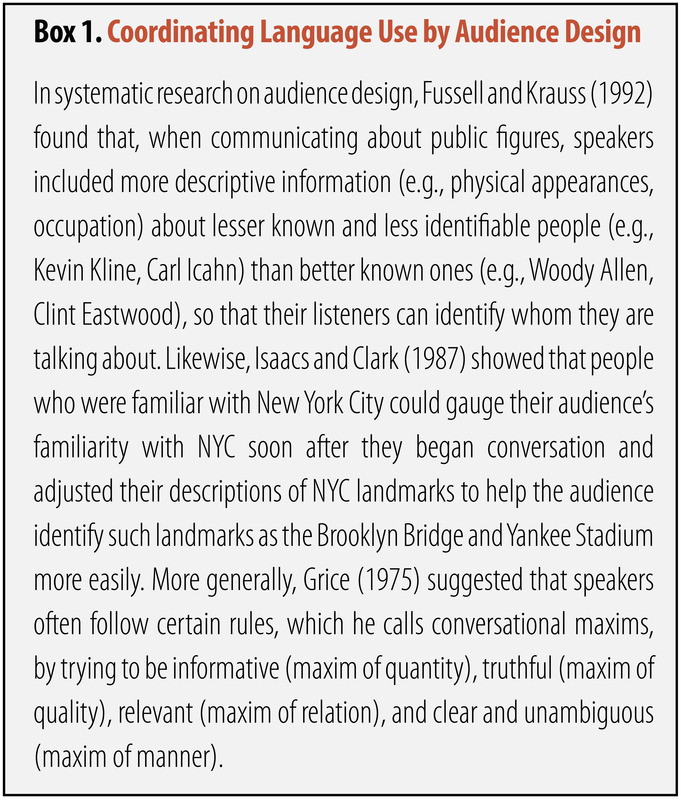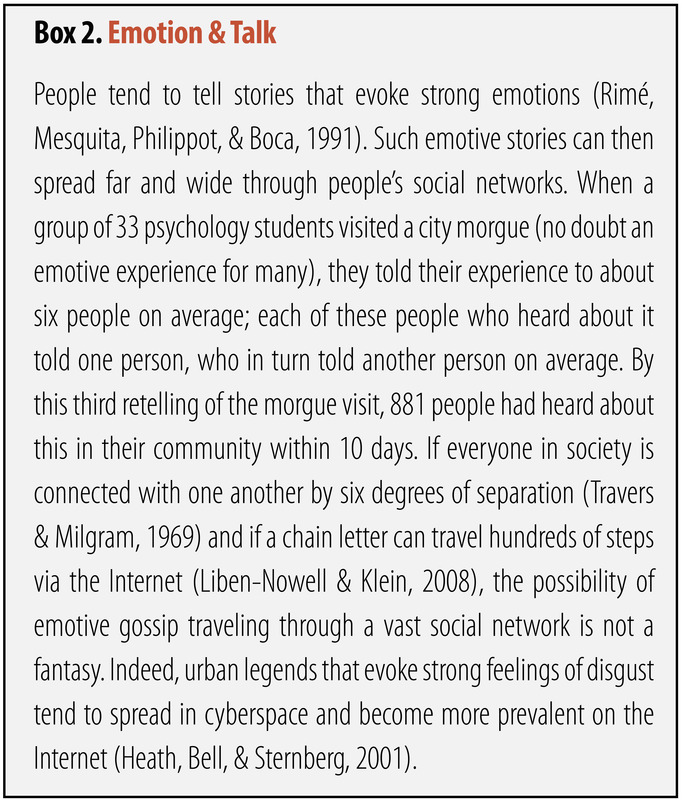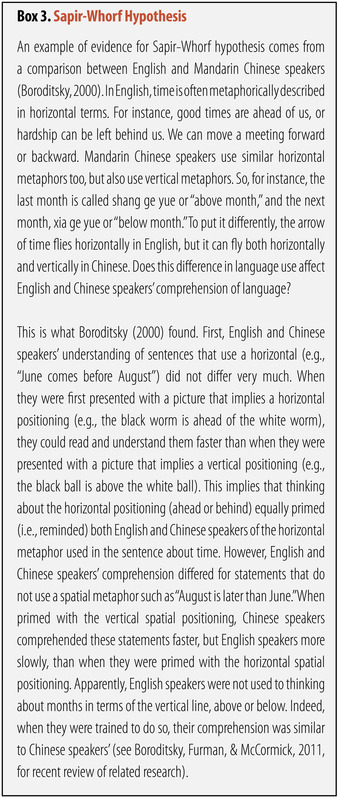30 Language and Language Use
Original chapter by Yoshi Kashima adapted by the Queen’s University Psychology Department
This Open Access chapter was originally written for the NOBA project. Information on the NOBA project can be found below.
Humans have the capacity to use complex language, far more than any other species on Earth. We cooperate with each other to use language for communication; language is often used to communicate about and even construct and maintain our social world. Language use and human sociality are inseparable parts of Homo sapiens as a biological species.
Learning Objectives
- Define basic terms used to describe language use.
- Describe the process by which people can share new information by using language.
- Characterize the typical content of conversation and its social implications.
- Characterize psychological consequences of language use and give an example.
Introduction
Imagine two men of 30-something age, Adam and Ben, walking down the corridor. Judging from their clothing, they are young businessmen, taking a break from work. They then have this exchange.
Adam: “You know, Gary bought a ring.”
Ben: “Oh yeah? For Mary, isn’t it?” (Adam nods.)
If you are watching this scene and hearing their conversation, what can you guess from this? First of all, you’d guess that Gary bought a ring for Mary, whoever Gary and Mary might be. Perhaps you would infer that Gary is getting married to Mary. What else can you guess? Perhaps that Adam and Ben are fairly close colleagues, and both of them know Gary and Mary reasonably well. In other words, you can guess the social relationships surrounding the people who are engaging in the conversation and the people whom they are talking about.

Language is used in our everyday lives. If psychology is a science of behavior, scientific investigation of language use must be one of the most central topics—this is because language use is ubiquitous. Every human group has a language; human infants (except those who have unfortunate disabilities) learn at least one language without being taught explicitly. Even when children who don’t have much language to begin with are brought together, they can begin to develop and use their own language. There is at least one known instance where children who had had little language were brought together and developed their own language spontaneously with minimum input from adults. In Nicaragua in the 1980s, deaf children who were separately raised in various locations were brought together to schools for the first time. Teachers tried to teach them Spanish with little success. However, they began to notice that the children were using their hands and gestures, apparently to communicate with each other. Linguists were brought in to find out what was happening—it turned out the children had developed their own sign language by themselves. That was the birth of a new language, Nicaraguan Sign Language (Kegl, Senghas, & Coppola, 1999). Language is ubiquitous, and we humans are born to use it.
How Do We Use Language?
If language is so ubiquitous, how do we actually use it? To be sure, some of us use it to write diaries and poetry, but the primary form of language use is interpersonal. That’s how we learn language, and that’s how we use it. Just like Adam and Ben, we exchange words and utterances to communicate with each other. Let’s consider the simplest case of two people, Adam and Ben, talking with each other. According to Clark (1996), in order for them to carry out a conversation, they must keep track of common ground. Common ground is a set of knowledge that the speaker and listener share and they think, assume, or otherwise take for granted that they share. So, when Adam says, “Gary bought a ring,” he takes for granted that Ben knows the meaning of the words he is using, whom Gary is, and what buying a ring means. When Ben says, “For Mary, isn’t it?” he takes for granted that Adam knows the meaning of these words, who Mary is, and what buying a ring for someone means. All these are part of their common ground.

Note that, when Adam presents the information about Gary’s purchase of a ring, Ben responds by presenting his inference about who the recipient of the ring might be, namely, Mary. In conversational terms, Ben’s utterance acts as evidence for his comprehension of Adam’s utterance—“Yes, I understood that Gary bought a ring”—and Adam’s nod acts as evidence that he now has understood what Ben has said too—“Yes, I understood that you understood that Gary has bought a ring for Mary.” This new information is now added to the initial common ground. Thus, the pair of utterances by Adam and Ben (called an adjacency pair) together with Adam’s affirmative nod jointly completes one proposition, “Gary bought a ring for Mary,” and adds this information to their common ground. This way, common ground changes as we talk, gathering new information that we agree on and have evidence that we share. It evolves as people take turns to assume the roles of speaker and listener, and actively engage in the exchange of meaning.
Common ground helps people coordinate their language use. For instance, when a speaker says something to a listener, he or she takes into account their common ground, that is, what the speaker thinks the listener knows. Adam said what he did because he knew Ben would know who Gary was. He’d have said, “A friend of mine is getting married,” to another colleague who wouldn’t know Gary. This is called audience design (Fussell & Krauss, 1992); speakers design their utterances for their audiences by taking into account the audiences’ knowledge. If their audiences are seen to be knowledgeable about an object (such as Ben about Gary), they tend to use a brief label of the object (i.e., Gary); for a less knowledgeable audience, they use more descriptive words (e.g., “a friend of mine”) to help the audience understand their utterances (Box 1).
 So, language use is a cooperative activity, but how do we coordinate our language use in a conversational setting? To be sure, we have a conversation in small groups. The number of people engaging in a conversation at a time is rarely more than four. By some counts (e.g., Dunbar, Duncan, & Nettle, 1995; James, 1953), more than 90 percent of conversations happen in a group of four individuals or less. Certainly, coordinating conversation among four is not as difficult as coordinating conversation among 10. But, even among only four people, if you think about it, everyday conversation is an almost miraculous achievement. We typically have a conversation by rapidly exchanging words and utterances in real time in a noisy environment. Think about your conversation at home in the morning, at a bus stop, in a shopping mall. How can we keep track of our common ground under such circumstances?
So, language use is a cooperative activity, but how do we coordinate our language use in a conversational setting? To be sure, we have a conversation in small groups. The number of people engaging in a conversation at a time is rarely more than four. By some counts (e.g., Dunbar, Duncan, & Nettle, 1995; James, 1953), more than 90 percent of conversations happen in a group of four individuals or less. Certainly, coordinating conversation among four is not as difficult as coordinating conversation among 10. But, even among only four people, if you think about it, everyday conversation is an almost miraculous achievement. We typically have a conversation by rapidly exchanging words and utterances in real time in a noisy environment. Think about your conversation at home in the morning, at a bus stop, in a shopping mall. How can we keep track of our common ground under such circumstances?
Pickering and Garrod (2004) argue that we achieve our conversational coordination by virtue of our ability to interactively align each other’s actions at different levels of language use: lexicon (i.e., words and expressions), syntax (i.e., grammatical rules for arranging words and expressions together), as well as speech rate and accent. For instance, when one person uses a certain expression to refer to an object in a conversation, others tend to use the same expression (e.g., Clark & Wilkes-Gibbs, 1986). Furthermore, if someone says “the cowboy offered a banana to the robber,” rather than “the cowboy offered the robber a banana,” others are more likely to use the same syntactic structure (e.g., “the girl gave a book to the boy” rather than “the girl gave the boy a book”) even if different words are involved (Branigan, Pickering, & Cleland, 2000). Finally, people in conversation tend to exhibit similar accents and rates of speech, and they are often associated with people’s social identity (Giles, Coupland, & Coupland, 1991). So, if you have lived in different places where people have somewhat different accents (e.g., United States and United Kingdom), you might have noticed that you speak with Americans with an American accent, but speak with Britons with a British accent.
Pickering and Garrod (2004) suggest that these interpersonal alignments at different levels of language use can activate similar situation models in the minds of those who are engaged in a conversation. Situation models are representations about the topic of a conversation. So, if you are talking about Gary and Mary with your friends, you might have a situation model of Gary giving Mary a ring in your mind. Pickering and Garrod’s theory is that as you describe this situation using language, others in the conversation begin to use similar words and grammar, and many other aspects of language use converge. As you all do so, similar situation models begin to be built in everyone’s mind through the mechanism known as priming. Priming occurs when your thinking about one concept (e.g., “ring”) reminds you about other related concepts (e.g., “marriage”, “wedding ceremony”). So, if everyone in the conversation knows about Gary, Mary, and the usual course of events associated with a ring—engagement, wedding, marriage, etc.— everyone is likely to construct a shared situation model about Gary and Mary. Thus, making use of our highly developed interpersonal ability to imitate (i.e., executing the same action as another person) and cognitive ability to infer (i.e., one idea leading to other ideas), we humans coordinate our common ground, share situation models, and communicate with each other.
What Do We Talk About?

What are humans doing when we are talking? Surely, we can communicate about mundane things such as what to have for dinner, but also more complex and abstract things such as the meaning of life and death, liberty, equality, and fraternity, and many other philosophical thoughts. Well, when naturally occurring conversations were actually observed (Dunbar, Marriott, & Duncan, 1997), a staggering 60%–70% of everyday conversation, for both men and women, turned out to be gossip—people talk about themselves and others whom they know. Just like Adam and Ben, more often than not, people use language to communicate about their social world.
Gossip may sound trivial and seem to belittle our noble ability for language—surely one of the most remarkable human abilities of all that distinguish us from other animals. Au contraire, some have argued that gossip—activities to think and communicate about our social world—is one of the most critical uses to which language has been put. Dunbar (1996) conjectured that gossiping is the human equivalent of grooming, monkeys and primates attending and tending to each other by cleaning each other’s fur. He argues that it is an act of socializing, signaling the importance of one’s partner. Furthermore, by gossiping, humans can communicate and share their representations about their social world—who their friends and enemies are, what the right thing to do is under what circumstances, and so on. In so doing, they can regulate their social world—making more friends and enlarging one’s own group (often called the ingroup, the group to which one belongs) against other groups (outgroups) that are more likely to be one’s enemies. Dunbar has argued that it is these social effects that have given humans an evolutionary advantage and larger brains, which, in turn, help humans to think more complex and abstract thoughts and, more important, maintain larger ingroups. Dunbar (1993) estimated an equation that predicts average group size of nonhuman primate genera from their average neocortex size (the part of the brain that supports higher order cognition). In line with his social brain hypothesis, Dunbar showed that those primate genera that have larger brains tend to live in larger groups. Furthermore, using the same equation, he was able to estimate the group size that human brains can support, which turned out to be about 150—approximately the size of modern hunter-gatherer communities. Dunbar’s argument is that language, brain, and human group living have co-evolved—language and human sociality are inseparable.
Dunbar’s hypothesis is controversial. Nonetheless, whether or not he is right, our everyday language use often ends up maintaining the existing structure of intergroup relationships. Language use can have implications for how we construe our social world. For one thing, there are subtle cues that people use to convey the extent to which someone’s action is just a special case in a particular context or a pattern that occurs across many contexts and more like a character trait of the person. According to Semin and Fiedler (1988), someone’s action can be described by an action verb that describes a concrete action (e.g., he runs), a state verb that describes the actor’s psychological state (e.g., he likes running), an adjective that describes the actor’s personality (e.g., he is athletic), or a noun that describes the actor’s role (e.g., he is an athlete). Depending on whether a verb or an adjective (or noun) is used, speakers can convey the permanency and stability of an actor’s tendency to act in a certain way—verbs convey particularity, whereas adjectives convey permanency. Intriguingly, people tend to describe positive actions of their ingroup members using adjectives (e.g., he is generous) rather than verbs (e.g., he gave a blind man some change), and negative actions of outgroup members using adjectives (e.g., he is cruel) rather than verbs (e.g., he kicked a dog). Maass, Salvi, Arcuri, and Semin (1989) called this a linguistic intergroup bias, which can produce and reproduce the representation of intergroup relationships by painting a picture favoring the ingroup. That is, ingroup members are typically good, and if they do anything bad, that’s more an exception in special circumstances; in contrast, outgroup members are typically bad, and if they do anything good, that’s more an exception.
 In addition, when people exchange their gossip, it can spread through broader social networks. If gossip is transmitted from one person to another, the second person can transmit it to a third person, who then in turn transmits it to a fourth, and so on through a chain of communication. This often happens for emotive stories (Box 2). If gossip is repeatedly transmitted and spread, it can reach a large number of people. When stories travel through communication chains, they tend to become conventionalized (Bartlett, 1932). A Native American tale of the “War of the Ghosts” recounts a warrior’s encounter with ghosts traveling in canoes and his involvement with their ghostly battle. He is shot by an arrow but doesn’t die, returning home to tell the tale. After his narration, however, he becomes still, a black thing comes out of his mouth, and he eventually dies. When it was told to a student in England in the 1920s and retold from memory to another person, who, in turn, retold it to another and so on in a communication chain, the mythic tale became a story of a young warrior going to a battlefield, in which canoes became boats, and the black thing that came out of his mouth became simply his spirit (Bartlett, 1932). In other words, information transmitted multiple times was transformed to something that was easily understood by many, that is, information was assimilated into the common ground shared by most people in the linguistic community. More recently, Kashima (2000) conducted a similar experiment using a story that contained a sequence of events that described a young couple’s interaction that included both stereotypical and counter-stereotypical actions (e.g., a man watching sports on TV on Sunday vs. a man vacuuming the house). After the retelling of this story, much of the counter-stereotypical information was dropped, and stereotypical information was more likely to be retained. Because stereotypes are part of the common ground shared by the community, this finding too suggests that conversational retellings are likely to reproduce conventional content.
In addition, when people exchange their gossip, it can spread through broader social networks. If gossip is transmitted from one person to another, the second person can transmit it to a third person, who then in turn transmits it to a fourth, and so on through a chain of communication. This often happens for emotive stories (Box 2). If gossip is repeatedly transmitted and spread, it can reach a large number of people. When stories travel through communication chains, they tend to become conventionalized (Bartlett, 1932). A Native American tale of the “War of the Ghosts” recounts a warrior’s encounter with ghosts traveling in canoes and his involvement with their ghostly battle. He is shot by an arrow but doesn’t die, returning home to tell the tale. After his narration, however, he becomes still, a black thing comes out of his mouth, and he eventually dies. When it was told to a student in England in the 1920s and retold from memory to another person, who, in turn, retold it to another and so on in a communication chain, the mythic tale became a story of a young warrior going to a battlefield, in which canoes became boats, and the black thing that came out of his mouth became simply his spirit (Bartlett, 1932). In other words, information transmitted multiple times was transformed to something that was easily understood by many, that is, information was assimilated into the common ground shared by most people in the linguistic community. More recently, Kashima (2000) conducted a similar experiment using a story that contained a sequence of events that described a young couple’s interaction that included both stereotypical and counter-stereotypical actions (e.g., a man watching sports on TV on Sunday vs. a man vacuuming the house). After the retelling of this story, much of the counter-stereotypical information was dropped, and stereotypical information was more likely to be retained. Because stereotypes are part of the common ground shared by the community, this finding too suggests that conversational retellings are likely to reproduce conventional content.
Psychological Consequences of Language Use
What are the psychological consequences of language use? When people use language to describe an experience, their thoughts and feelings are profoundly shaped by the linguistic representation that they have produced rather than the original experience per se (Holtgraves & Kashima, 2008). For example, Halberstadt (2003) showed a picture of a person displaying an ambiguous emotion and examined how people evaluated the displayed emotion. When people verbally explained why the target person was expressing a particular emotion, they tended to remember the person as feeling that emotion more intensely than when they simply labeled the emotion.

Thus, constructing a linguistic representation of another person’s emotion apparently biased the speaker’s memory of that person’s emotion. Furthermore, linguistically labeling one’s own emotional experience appears to alter the speaker’s neural processes. When people linguistically labeled negative images, the amygdala—a brain structure that is critically involved in the processing of negative emotions such as fear—was activated less than when they were not given a chance to label them (Lieberman et al., 2007). Potentially because of these effects of verbalizing emotional experiences, linguistic reconstructions of negative life events can have some therapeutic effects on those who suffer from the traumatic experiences (Pennebaker & Seagal, 1999). Lyubomirsky, Sousa, and Dickerhoof (2006) found that writing and talking about negative past life events improved people’s psychological well-being, but just thinking about them worsened it. There are many other examples of effects of language use on memory and decision making (Holtgraves & Kashima, 2008).
 Furthermore, if a certain type of language use (linguistic practice) (Holtgraves & Kashima, 2008) is repeated by a large number of people in a community, it can potentially have a significant effect on their thoughts and action. This notion is often called Sapir-Whorf hypothesis (Sapir, 1921; Whorf, 1956; Box 3). For instance, if you are given a description of a man, Steven, as having greater than average experience of the world (e.g., well-traveled, varied job experience), a strong family orientation, and well-developed social skills, how do you describe Steven? Do you think you can remember Steven’s personality five days later? It will probably be difficult. But if you know Chinese and are reading about Steven in Chinese, as Hoffman, Lau, and Johnson (1986) showed, the chances are that you can remember him well. This is because English does not have a word to describe this kind of personality, whereas Chinese does (shì gù). This way, the language you use can influence your cognition. In its strong form, it has been argued that language determines thought, but this is probably wrong. Language does not completely determine our thoughts—our thoughts are far too flexible for that—but habitual uses of language can influence our habit of thought and action. For instance, some linguistic practice seems to be associated even with cultural values and social institution. Pronoun drop is the case in point. Pronouns such as “I” and “you” are used to represent the speaker and listener of a speech in English. In an English sentence, these pronouns cannot be dropped if they are used as the subject of a sentence. So, for instance, “I went to the movie last night” is fine, but “Went to the movie last night” is not in standard English. However, in other languages such as Japanese, pronouns can be, and in fact often are, dropped from sentences. It turned out that people living in those countries where pronoun drop languages are spoken tend to have more collectivistic values (e.g., employees having greater loyalty toward their employers) than those who use non–pronoun drop languages such as English (Kashima & Kashima, 1998). It was argued that the explicit reference to “you” and “I” may remind speakers the distinction between the self and other, and the differentiation between individuals. Such a linguistic practice may act as a constant reminder of the cultural value, which, in turn, may encourage people to perform the linguistic practice.
Furthermore, if a certain type of language use (linguistic practice) (Holtgraves & Kashima, 2008) is repeated by a large number of people in a community, it can potentially have a significant effect on their thoughts and action. This notion is often called Sapir-Whorf hypothesis (Sapir, 1921; Whorf, 1956; Box 3). For instance, if you are given a description of a man, Steven, as having greater than average experience of the world (e.g., well-traveled, varied job experience), a strong family orientation, and well-developed social skills, how do you describe Steven? Do you think you can remember Steven’s personality five days later? It will probably be difficult. But if you know Chinese and are reading about Steven in Chinese, as Hoffman, Lau, and Johnson (1986) showed, the chances are that you can remember him well. This is because English does not have a word to describe this kind of personality, whereas Chinese does (shì gù). This way, the language you use can influence your cognition. In its strong form, it has been argued that language determines thought, but this is probably wrong. Language does not completely determine our thoughts—our thoughts are far too flexible for that—but habitual uses of language can influence our habit of thought and action. For instance, some linguistic practice seems to be associated even with cultural values and social institution. Pronoun drop is the case in point. Pronouns such as “I” and “you” are used to represent the speaker and listener of a speech in English. In an English sentence, these pronouns cannot be dropped if they are used as the subject of a sentence. So, for instance, “I went to the movie last night” is fine, but “Went to the movie last night” is not in standard English. However, in other languages such as Japanese, pronouns can be, and in fact often are, dropped from sentences. It turned out that people living in those countries where pronoun drop languages are spoken tend to have more collectivistic values (e.g., employees having greater loyalty toward their employers) than those who use non–pronoun drop languages such as English (Kashima & Kashima, 1998). It was argued that the explicit reference to “you” and “I” may remind speakers the distinction between the self and other, and the differentiation between individuals. Such a linguistic practice may act as a constant reminder of the cultural value, which, in turn, may encourage people to perform the linguistic practice.
Conclusion
Language and language use constitute a central ingredient of human psychology. Language is an essential tool that enables us to live the kind of life we do. Can you imagine a world in which machines are built, farms are cultivated, and goods and services are transported to our household without language? Is it possible for us to make laws and regulations, negotiate contracts, and enforce agreements and settle disputes without talking? Much of contemporary human civilization wouldn’t have been possible without the human ability to develop and use language. Like the Tower of Babel, language can divide humanity, and yet, the core of humanity includes the innate ability for language use. Whether we can use it wisely is a task before us in this globalized world.
Check Your Knowledge
To help you with your studying, we’ve included some practice questions for this module. These questions do not necessarily address all content in this module. They are intended as practice, and you are responsible for all of the content in this module even if there is no associated practice question. To promote deeper engagement with the material, we encourage you to create some questions of your own for your practice. You can then also return to these self-generated questions later in the course to test yourself.
Vocabulary
- Audience design
- Constructing utterances to suit the audience’s knowledge.
- Common ground
- Information that is shared by people who engage in a conversation.
- Ingroup
- Group to which a person belongs.
- Lexicon
- Words and expressions.
- Linguistic intergroup bias
- A tendency for people to characterize positive things about their ingroup using more abstract expressions, but negative things about their outgroups using more abstract expressions.
- Outgroup
- Group to which a person does not belong.
- Priming
- A stimulus presented to a person reminds him or her about other ideas associated with the stimulus.
- Sapir-Whorf hypothesis
- The hypothesis that the language that people use determines their thoughts.
- Situation model
- A mental representation of an event, object, or situation constructed at the time of comprehending a linguistic description.
- The hypothesis that the human brain has evolved, so that humans can maintain larger ingroups.
- Networks of social relationships among individuals through which information can travel.
- Syntax
- Rules by which words are strung together to form sentences.
References
- Bartlett, F. C. (1932). Remembering: A study in experimental and social psychology. Cambridge, UK: Cambridge University Press.
- Branigan, H. P., Pickering, M. J., & Cleland, A. A. (2000). Syntactic co-ordination in dialogue. Cognition, 75, B13–25.
- Clark, H. H. (1996). Using language. Cambridge, UK: Cambridge University Press.
- Clark, H. H., & Wilkes-Gibbs, D. (1986). Referring as a collaborative process. Cognition, 22, 1–39.
- Dunbar, R. (1996). Grooming, gossip, and the evolution of language. Boston, MA: Harvard University Press.
- Dunbar, R. I. M. (1993). Coevolution of neorcortical size, group size and language in humans. Behavioral and Brain Sciences, 16, 681–735.
- Dunbar, R. I. M., Duncan, N. D. C., & Nettle, D. (1995). Size and structure of freely forming conversational groups. Human Nature, 6, 67–78.
- Dunbar, R. I. M., Marriott, A., & Duncan, N. D. C. (1997). Human conversational behaviour. Human Nature, 8, 231–246.
- Fussell, S. R., & Krauss, R. M. (1992). Coordination of knowledge in communication: Effects of speakers’ assumptions about what others know. Journal of Personality and Social Psychology, 62, 378–391.
- Giles, H., Coupland, N., & Coupland, J. (1991) Accommodation theory: Communication, context, and consequence. In H. Giles, J. Coupland, & N. Coupland (Eds.), Contexts of accommodation: Developments in applied sociolinguistics (pp. 1–68). Cambridge, UK: Cambridge University Press.
- Halberstadt, J. (2003). The paradox of emotion attribution: Explanation biases perceptual memory for emotional expressions. Current Directions in Psychological Science, 12, 197–201.
- Hoffman, C., Lau, I., & Johnson, D. R. (1986). The linguistic relativity of person cognition: An English-Chinese comparison. Journal of Personality and Social Psychology, 51, 1097–1105.
- Holtgraves, T. M., & Kashima, Y. (2008). Language, meaning, and social cognition. Personality and Social Psychology Review, 12, 73–94.
- James, J. (1953). The distribution of free-forming small group size. American Sociological Review, 18, 569–570.
- Kashima, E., & Kashima, Y. (1998). Culture and language: The case of cultural dimensions and personal pronoun use. Journal of Cross-Cultural Psychology, 29, 461–486.
- Kashima, Y. (2000). Maintaining cultural stereotypes in the serial reproduction of narratives. Personality and Social Psychology Bulletin, 26, 594–604.
- Kegl, J., Senghas, A., & Coppola, M. (1999). Creation through contact: Sign language emergence and sign language change in Nicaragua. In M. DeGraff (Ed.), Language creation and language change Creolization, diachrony, and development (pp. 179–237). Cambridge, MA: The MIT Press.
- Lieberman, M., Eisenberger, N. I., Crockett, M. J., Tom, S. M., Pfeifer, J. H., & Way, B. W. (2007). Putting feelings into words. Psychological Science, 18, 421–428.
- Lyubomirsky, S., Sousa, L., & Dickerhoof, R. (2006). The costs and benefits of writing, talking, and thinking about life’s triumphs and defeats. Journal of Personality and Social Psychology, 90, 692–708.
- Maass, A., Salvi, D., Arcuri, L., & Semin, G. (1989). Language use in intergroup contexts: The linguistic intergroup bias. Journal of Personality and Social Psychology, 57, 981–993.
- Pennebaker, J. W., & Seagal, J. (1999). Forming a story: The health benefits of narrative. Journal of Clinical Psychology, 55, 1243–1254.
- Pickering, M. J., & Garrod, S. (2004). Toward a mechanistic psychology of dialogue. Behavioral and Brain Sciences, 27, 169–226.
- Sapir, E. (1921). Language: An introduction to the study of speech. New York, NY: Harcourt Brace.
- Semin, G., & Fiedler, K. (1988). The cognitive functions of linguistic categories in describing persons: Social cognition and language. Journal of Personality and Social Psychology, 54, 558–568.
- Whorf, B. L. (1956). Language, thought, and reality (J. B. Carroll, Ed.). Cambridge, MA: MIT Press.
How to cite this Chapter using APA Style:
Kashima, Y. (2019). Language and language use. Adapted for use by Queen’s University. Original chapter in R. Biswas-Diener & E. Diener (Eds), Noba textbook series: Psychology. Champaign, IL: DEF publishers. Retrieved from http://noba.to/gq62cpam
Copyright and Acknowledgment:
This material is licensed under the Creative Commons Attribution-NonCommercial-ShareAlike 4.0 International License. To view a copy of this license, visit: http://creativecommons.org/licenses/by-nc-sa/4.0/deed.en_US.
This material is attributed to the Diener Education Fund (copyright © 2018) and can be accessed via this link: http://noba.to/gq62cpam.
Additional information about the Diener Education Fund (DEF) can be accessed here.
Kegl, J., Senghas, A., & Coppola, M. (1999). Creation through contact: Sign language emergence and sign language change in Nicaragua. In M. DeGraff (Ed.), Language creation and language change Creolization, diachrony, and development (pp. 179–237). Cambridge, MA: The MIT Press.
Clark, H. H. (1996). Using language. Cambridge, UK: Cambridge University Press.
Information that is shared by people who engage in a conversation.
Constructing utterances to suit the audience’s knowledge.
Fussell, S. R., & Krauss, R. M. (1992). Coordination of knowledge in communication: Effects of speakers’ assumptions about what others know. Journal of Personality and Social Psychology, 62, 378–391.
Dunbar, R. I. M., Duncan, N. D. C., & Nettle, D. (1995). Size and structure of freely forming conversational groups. Human Nature, 6, 67–78.
James, J. (1953). The distribution of free-forming small group size. American Sociological Review, 18, 569–570.
Pickering, M. J., & Garrod, S. (2004). Toward a mechanistic psychology of dialogue. Behavioral and Brain Sciences, 27, 169–226.
Words and expressions.
Rules by which words are strung together to form sentences.
Clark, H. H., & Wilkes-Gibbs, D. (1986). Referring as a collaborative process. Cognition, 22, 1–39.
Giles, H., Coupland, N., & Coupland, J. (1991) Accommodation theory: Communication, context, and consequence. In H. Giles, J. Coupland, & N. Coupland (Eds.), Contexts of accommodation: Developments in applied sociolinguistics (pp. 1–68). Cambridge, UK: Cambridge University Press.
A mental representation of an event, object, or situation constructed at the time of comprehending a linguistic description.
Dunbar, R. I. M., Marriott, A., & Duncan, N. D. C. (1997). Human conversational behaviour. Human Nature, 8, 231–246.
Dunbar, R. (1996). Grooming, gossip, and the evolution of language. Boston, MA: Harvard University Press.
Group to which a person belongs.
Group to which a person does not belong.
Dunbar, R. I. M. (1993). Coevolution of neorcortical size, group size and language in humans. Behavioral and Brain Sciences, 16, 681–735.
The hypothesis that the human brain has evolved, so that humans can maintain larger ingroups.
Semin, G., & Fiedler, K. (1988). The cognitive functions of linguistic categories in describing persons: Social cognition and language. Journal of Personality and Social Psychology, 54, 558–568.
Maass, A., Salvi, D., Arcuri, L., & Semin, G. (1989). Language use in intergroup contexts: The linguistic intergroup bias. Journal of Personality and Social Psychology, 57, 981–993.
A tendency for people to characterize positive things about their ingroup using more abstract expressions, but negative things about their outgroups using more abstract expressions.
Networks of social relationships among individuals through which information can travel.
Bartlett, F. C. (1932). Remembering: A study in experimental and social psychology. Cambridge: Cambridge University Press.
Kashima, Y. (2000). Maintaining cultural stereotypes in the serial reproduction of narratives. Personality and Social Psychology Bulletin, 26, 594–604.
Holtgraves, T. M., & Kashima, Y. (2008). Language, meaning, and social cognition. Personality and Social Psychology Review, 12, 73–94.
Halberstadt, J. (2003). The paradox of emotion attribution: Explanation biases perceptual memory for emotional expressions. Current Directions in Psychological Science, 12, 197–201.
Lieberman, M., Eisenberger, N. I., Crockett, M. J., Tom, S. M., Pfeifer, J. H., & Way, B. W. (2007). Putting feelings into words. Psychological Science, 18, 421–428.
Pennebaker, J. W., & Seagal, J. (1999). Forming a story: The health benefits of narrative. Journal of Clinical Psychology, 55, 1243–1254.
Lyubomirsky, S., Sousa, L., & Dickerhoof, R. (2006). The costs and benefits of writing, talking, and thinking about life’s triumphs and defeats. Journal of Personality and Social Psychology, 90, 692–708.
The hypothesis that the language that people use determines their thoughts.
Sapir, E. (1921). Language: An introduction to the study of speech. New York, NY: Harcourt Brace.
Whorf, B. L. (1956). Language, thought, and reality (J. B. Carroll, Ed.). Cambridge, MA: MIT Press.
Hoffman, C., Lau, I., & Johnson, D. R. (1986). The linguistic relativity of person cognition: An English-Chinese comparison. Journal of Personality and Social Psychology, 51, 1097–1105.
Kashima, E., & Kashima, Y. (1998). Culture and language: The case of cultural dimensions and personal pronoun use. Journal of Cross-Cultural Psychology, 29, 461–486.
